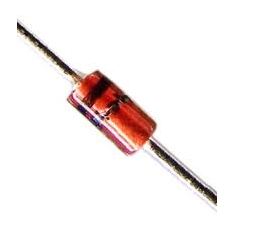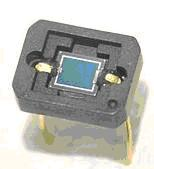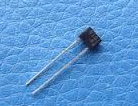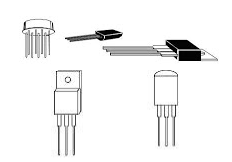Minggu, 17 Juli 2016
way DIODE TESTING BY OHM METER
16.36
It required an ohmmeter multitester or an analog / digital. Multitester or Avometer Analog has facilities measuring barrier (ohmmeter) where the type normally used ohmmeter ohmmeter-series, which is the construction of the polarity of the batteries installed in the meter opposite in polarity to the measuring terminal. Or in other words, the positive terminal meter is having a negative polarity battery, reverse the negative terminal of battery meter has a positive polarity.
Thus in order to test a diode by using Avometer principle is as follows:
- Your position Avometer ohm position with sub-scale
- Decide in advance the electrode anode and cathode of the diode
- Connect the terminal + (positive) meter with the anode of the diode to be tested while the terminal - (negative) meter with the cathode of the diode. (This relationship is the reverse)
- In this position, if the diode is good, then the meter needle will not move. However, if the needle moves in this position, it can be said short-circuit diode (defective).
- Repeat step 2 above with the opposite polarity, which is connected with the negative meter Anode and Cathode with positive meters. (This relationship is forward).
- In this position, if the diode is good, then the meter needle will move. But if in this position the needle meter does not move, it can be said diode broke (broken).
itulah pembahasan singkat cara menguji dioda dengan ohm meter. semoga dapat bermanfaat. maaf bila banyak kesalahan, karena ini dari google translate
Senin, 11 Juli 2016
Type - Type Transformer whether the transformer pal including
16.25
the transformer is a device used to raise or lower the electric current. when viewed from the method of use, there are many types of transformers.
however, when viewed from the way it works, the transformer is only divided into two types.
that is :
transformer step-up and step-down transformer
and for its use, the transformer is divided among them:

Transformer Adaptor
assisted by diodes, transformers is useful to convert AC into DC current through the coil primary and secondary windings. Typically used for power supply circuit. transformer of this type has a roll to change the power voltage 110 volts to 220 volts. The rolls (coils) is called the primary winding. Before the change becomes a DC current, an electric voltage is passed through thousands conductor (coil) which ends at the secondary winding.
These components are widely sold in the market with the size and specific purposes. whereas its properties are as follows:
The physical form of the transformer is: a rectangular plate coated with a thin and rolls of paper closed. There are a few feet, the primary windings are three legs, while the secondary is not less than nine feet
The primary winding receives AC current PLN between 110-240 Volt
Secondary windings produce DC current after AC current in the second winding process on this. voltage issued from 4 to 12 volts
Transformer IF (intermediate frequency)
This transformer is used for the intermediate frequency of the amplifier, usually found in the receiving radio relic. are now rarely wears transformer electronic devices of this type. Ikeja how this transformer is capturing sound waves emitted by radio transmitters and then on though through other components. subsequently issued in the form of sound (sound). IF transformer has the physical form of a square, on a surface right in the middle there is a gap to rotate when correcting the sound emission from the radio transmitter.
The advantages of this IF transformer is:
Can be altered when looking for precisely targeted beam using a screwdriver;
The size is small making it easier for beginners when installing
Retains the primary and secondary windings
The output transformer (OT)
This component can also be called transformer OT. These components are widely used in amplifier circuits, radio receivers, tape recorder and a set of electronics that produce other sounds. Physical form is almost the same with the other transformer dhania different sizes. Contains the coil windings of Nikulin. The size of the inflow depends on the coil.
Part transverse reinforcing plates and paper package, it is used as a separate circuit breaker on the primary and secondary windings. At the bottom of the foot swell, there are five foot two on the output and three parts in (inflows).
however, when viewed from the way it works, the transformer is only divided into two types.
that is :
transformer step-up and step-down transformer
and for its use, the transformer is divided among them:

Transformer Adaptor
assisted by diodes, transformers is useful to convert AC into DC current through the coil primary and secondary windings. Typically used for power supply circuit. transformer of this type has a roll to change the power voltage 110 volts to 220 volts. The rolls (coils) is called the primary winding. Before the change becomes a DC current, an electric voltage is passed through thousands conductor (coil) which ends at the secondary winding.
These components are widely sold in the market with the size and specific purposes. whereas its properties are as follows:
The physical form of the transformer is: a rectangular plate coated with a thin and rolls of paper closed. There are a few feet, the primary windings are three legs, while the secondary is not less than nine feet
The primary winding receives AC current PLN between 110-240 Volt
Secondary windings produce DC current after AC current in the second winding process on this. voltage issued from 4 to 12 volts
Transformer IF (intermediate frequency)
This transformer is used for the intermediate frequency of the amplifier, usually found in the receiving radio relic. are now rarely wears transformer electronic devices of this type. Ikeja how this transformer is capturing sound waves emitted by radio transmitters and then on though through other components. subsequently issued in the form of sound (sound). IF transformer has the physical form of a square, on a surface right in the middle there is a gap to rotate when correcting the sound emission from the radio transmitter.
The advantages of this IF transformer is:
Can be altered when looking for precisely targeted beam using a screwdriver;
The size is small making it easier for beginners when installing
Retains the primary and secondary windings
The output transformer (OT)
This component can also be called transformer OT. These components are widely used in amplifier circuits, radio receivers, tape recorder and a set of electronics that produce other sounds. Physical form is almost the same with the other transformer dhania different sizes. Contains the coil windings of Nikulin. The size of the inflow depends on the coil.
Part transverse reinforcing plates and paper package, it is used as a separate circuit breaker on the primary and secondary windings. At the bottom of the foot swell, there are five foot two on the output and three parts in (inflows).
Working Principle Transformer and how the calculation formula
15.39
The transformer (transformer) is a tool used to raise or lower the alternating voltage (AC)
The transformer consists of three basic components, namely:
- The first coil (primary) that as input.
- The second coil (secondary) are as output.
- The iron core that serves to amplify the magnetic field generated.
The working principle of a transformer that is, when the primary coil is connected to an alternating voltage source (AC), changes in electrical current in the primary coil lead to a changing magnetic field. Changing magnetic field is strengthened by the presence of an iron core and iron core is delivered to the secondary coil, so that the ends of the secondary coil induced emf will arise.
This effect is called mutual inductance (mutual inductance).
when the electric current flowing from the voltage source to the primary coil reversed (changed polarity) magnetic field generated will change direction so that the electric current generated in the secondary coil will change polarity.
The relationship between the primary voltage, the number of primary winding, secondary voltage, and the number of secondary windings, can be expressed by the equation:
Vp = primary voltage (volts)
Vs = secondary voltage (volts)
Np = number of primary windings
Ns = number of secondary windings
symbol Transformer
Based on the ratio between the primary winding and the number of secondary transformer windings there are two types:
- A step-up transformer is a transformer that converts alternating voltage is low to high, this transformer has a number of windings of the secondary coil are more than the number of the primary winding (Ns> Np).
- The step-down transformer is a transformer that converts alternating voltage is high to low, the transformer has primary coil windings amount more than the amount of the secondary winding (Np> Ns).
On transformer (transformer) the magnitude of the voltage issued by the secondary coil is:
1. In proportion to the number of secondary windings (Vs ~ Ns).
2. In proportion to the magnitude of the primary voltage (VS ~ VP).
3. Inversely proportional to the number of primary winding,
The use of transformers
The transformer (transformer) used in electrical equipment particularly those requiring changes or adjustments to the magnitude of an alternating voltage. Eg radio requires a voltage of 12 volts when 220 volts of electricity, it would require a transformer to convert an alternating electric voltage of 220 volts to an alternating electric voltage of 12 volts.
Examples of power tools that require a transformer is:
- TV
- Computers
- Photocopy machine
- Powerhouse
- Etc.
Examples of how to calculate the number of secondary windings:
To turn on the lamp voltage of 10 volts to 220 volts of electricity use the step-down transformer. If the number of windings of the transformer primary winding 1100, what is the number of turns on the secondary coil?
completion:
Note: Vp = 220 V
Vs = 10 V
Winding Np = 1100
Asked: Ns = ...........?
Jumat, 01 Juli 2016
Digital Number Systems and Conversion Numbers, Binary , Octal , Decimal , hexadecimal
15.28
Digital system is a system that serves to measure a value , or the amount of
which is fixed , or irregular in discrete form . be a digit or digits digits
digits . Usually before learning more about digital systems , first you would
have to learn the name of Numbers System . The number system has four types
namely Binary , Octal , Decimal , hexadecimal .
Biner
Binary is a number
-based system of two , and only had two pieces of symbols , 0 and 1. The modern
binary number system was discovered by Gottfried Wilhelm Leibniz in the 17th
century . The number system is the basis of all digital -based number system .
In the writing is usually written as follows 1010012 , 10012 , 10102 , etc .
Octal
Octal
is a numbers -based system of eight and had eight different symbols (
0,1,2,3,4,5,6,7 ) . In the writing is usually written as follows 23 078 , 23
558 , 1028 , etc .
Decimal
Decimal
is a number -based system of ten and has 10 different symbols (
0,1,2,3,4,5,6,7,8,9 ) . The decimal number system commonly used by humans in
everyday life .
Hexadecimal
Hexadecimal
is a numbers -based system 16 and has 16 different symbols ( 0,1,2,3,4,5,6,7,8,9
, A, B , C , D , E , F ) . In the writing is usually written as follows 2D8616
, 12DA16 , FA16 , etc .
Conversion Number
Conversion
Number is used to change a number of a system of numbers into numbers in a
number system to another.
Binary
Binary to Decimal
How to transform into
a binary number Decimal number by multiplying 2n where n is a number that
starts from the position of the numbers 0 and counted from behind .
Example
: 1100012 converted into Decimal numbers
1100012
= ( 1 x 25 ) + ( 1 x 24 ) + ( 0 x 23 ) + ( 0 x 22 ) + ( 0 x 21 ) + ( 1 x 20 )
=
32 + 16 + 0 + 0 + 0 + 1
=
49
Thus
, 110 012 = 49
Binary To Octal
How
to change the binary number into octal numbers by taking a three -digit number
from the right .
Example
: 111100110012 be converted into octal numbers
11
110 011 001 = 112 = 21 + 20 = 38
=
1102 = 22 + 21 = 68
=
0112 = 21 + 20 = 38
=
0012 = 20 = 18
So
, 111100110012 = 36 318
Binary to Hexadecimal
How
to change the binary into hexadecimal by taking four digit number from the
right .
Example
: 01001111010111002 converted to hexadecimal
0100
1111 0101 1100 = 01002 = 22 = 416
=
11112 = 23 + 22 + 21 + 20 = 15 - F16
=
01012 = 22 + 20 = 516
=
11002 = 23 + 22 = 12 - C16
So
01001111010111002 = 4F5C16
Octal
Octal To Binary
How
to transform numbers into Binary Octal , is to make one by one the numbers
Octal numbers into binary numbers first, then united . For Octal numbers must
have a 3 -digit binary number , so that if it produces less than 3 digits of
eating in front of added numbers 0
Example
: 2618 is converted into a binary number
261
= 28 = 0102
=
68 = 1102
=
18 = 0012
So , in 2618 =
0,101,100,012 .
Oktal To Decimal
How to transform into
a number Octal Decimal numbers by changing the number Octal , Binary numbers
must first become new we change into Decimal numbers .
Example
: 2618 is converted into Decimal numbers Step 1 : change the number to Binary
261 = 28 = 0102 = 68 = 1102 = 18 = 0012 So , in 2618 = 0,101,100,012 Step 2 :
turning numbers into Decimal Binary 0101100012 = ( 0 x 28 ) + ( 1 x 27 ) + ( 0
x 26 ) + ( 1 x 25 ) + ( 1 x 24 ) + ( 0 x 23 ) + ( 0 x 22 ) + ( 0 x 21 ) + ( 1 x
20 ) = 128 + 0 + 0 + 32 + 16 + 0 + 0 + 0 + 1 = 177 So , 2618 = 177
Okta To Hexadecimal
How
to change into hexadecimal numbers Octal numbers Octal by changing into binary
numbers first before we change into Decimal numbers . Then we change again into
hexadecimal .
Example
: 2618 is converted to hexadecimal
Step
1 : change the number to Binary
261
= 28 = 0102
=
68 = 1102
=
18 = 0012
So
, in 2618 = 0,101,100,012
Step
2 : turning numbers into Decimal Binary 0101100012 = ( 0 x 28 ) + ( 1 x 27 ) +
( 0 x 26 ) + ( 1 x 25 ) + ( 1 x 24 ) + ( 0 x 23 ) + ( 0 x 22 ) + ( 0 x 21 ) + (
1 x 20 ) = 128 + 0 + 0 + 32 + 16 + 0 + 0 + 0 + 1 = 177
Step
3 : turning numbers into hexadecimal Decimal 177 us for the 16-117 : 16 = 11
remainder 1 11 : 16 = 0 remainder 11 - B Reading from the bottom then becomes
B1 So 2618 = B116
Decimal
Decimal To Binary
How
to change the Decimal numbers into Binary , Decimal is to divide the number by
2 and write the rest from the bottom to the top .
Example
: 25 is converted into binary numbers
25
: 2 = 12 remainder 1
12
: 2 = 6 remainder 0
6
: 2 = 3 remainder 0
3
: 2 = 1 remainder 1
1
: 2 = 0 remainder 1
then
written 11001
So
25 = 110 012
Decimal To Octal
How
to change into Octal Decimal numbers , namely by dividing Decimal numbers with
the numbers 8 and write the rest from the bottom to the top .
Example
: 80 is converted into numbers Octal 80 : 8 = 10 remainder 0 10 : 8 = 1 the
remaining 2 1 : 8 = 0 remainder 1 then written 120 So 80 = 1208
Decimal To Hexadecimal
How
to change the Decimal numbers into hexadecimal , namely by dividing Decimal
numbers with the numbers 16 and write the rest from the bottom to the top .
Example
: 275 is converted to hexadecimal 275 : 16 = 17 remaining 3 17 : 16 = 1
remainder 1 1 : 16 = 0 remainder 1 then written 113 So 275 = 11316
Hexadecimal
Hexadecimal To Binary
How
to change the hexadecimal into binary , by making one by one hexadecimal
numbers into binary numbers first, then united . For hexadecimal numbers must
have a 4 digit binary , so if only produces less than 4 digits of eating in
front of added numbers 0 .
Example
: 4DA216 converted into binary numbers 4DA2 = 416 = 01002 = D16 = 11012 = A16 =
10102 = 216 = 00102 So 4DA216 = 01001101101000102
HExadecimal To Octal
How to change into
hexadecimal numbers Octal , is to mngubah hexadecimal numbers Decimal becomes
first, we change into octal numbers .
Example
: 3C216 converted into numbers Octal Step 1 : Change the hexadecimal be Decimal
3C216 = ( 3 x 162 ) + ( C ( 12 ) x 161 ) + ( 2 x 160 ) = 768 + 192 + 2 = 962
Step
2 : Change the Decimal numbers into Octal
962
: 8 = 120 remaining 2
120
: 8 = 15 remainder 0
15
: 8 = 1 remaining 7
1
: 8 = 0 remainder 1
it
was written in 1702
So
3C216 = 17028
Hexadecimal To decimal
How to change a binary
number to decimal, is to multiply 16N , where n is a number that starts from
the position of the numbers 0 and counted from behind .
Example
: 3C216 converted into Decimal numbers 3C216 = ( 3 x 162 ) + ( C ( 12 ) x 161 )
+ ( 2 x 160 ) = 768 + 192 + 2 = 962 So 3C216 = 962
the types of diodes and functions in electronic circuits
05.35
the types of diodes and functions in electronic circuits
on this occasion , I will discuss the types of diodes , and functions in electronic circuits .
There are various types of diodes are made in accordance with its function . without leaving the characteristics and specifications , such as a diode rectifier ( rectifier ) , light emission diode ( LED ) , Zenner diodes , photodiodes ( Photo - Diode ) and Diodes Varactor .
The following I present some kind along with the function of the diode
Rectifier diodes
Is a type of diode rectifier diodes made from silicon material , which serves as a rectifier voltage / current from alternating current ( AC ) to direct current ( dc ) , or change the AC current into dc .
The legs of the diode are the cathode leg marked with lines on the ends

DIODE-ZENER
Zener diode is a diode junction P and N are made from raw material silicon . This diode is also known as Voltage Regulation Diode , which works on a reverse area ( quadrant III ) . Potential zener diode ranges from 2.4 to 200 volts with power dissipation from ¼ to 50 watts .This diode breakdown voltage phenomenon inspired the creation of an electronic component called Zener diodes relatives . There is no difference in the basic structure of a Zener diode . By giving the amount of doping is more at the junction P and N , it turns the diode breakdown voltage can be more quickly achieved. If the diode is usually only occurred breakdown at a voltage of hundreds of volts , the Zener may occur in the numbers of tens and units of volts

In the datasheet there Zener voltage Vz which has amounted to 2 volts , 5.6 volts , and so on . The function of these components is usually used for securing the circuit after the Zener voltage .
Consider the following circuit , the input voltage will be coming to another circuit , and the load will be limited by the zener diode . If the input voltage is below 5.6V , the diode does not conduct current so that the current will flow to other circuits and loads . If the input voltage reaches 5.6 V or more it will happen breakdown zener diode and current will flow through the diode and not to the circuit or load .
Light emitting diode
A light emitting diode or LED is known by the acronym of Solid State Lamp which is a combination of electronic devices with optical electronics , so it is classified in the family " Optoelectronic " . While the electrodes the same as the other diodes , the anode ( + ) and cathode ( - ) . There are three general categories of use LEDs, namely :
- As an indicator light ,
- For the transmission of light signals are modulated within a certain distance ,
- As electronic circuits isolated coupling in total. Symbol,
wake up physically and construction is shown in the following figure .
The basic ingredients used in the manufacture of LEDs is a material gallium arsenide ( GaAs ) or gallium arsenide Phosphide ( GAAP ) or Gallium also Phosphide ( GaP ) , these materials emit light with different colors . GaAs material emits infra - red light , the light emitting material Grasp red or yellow , while the GaP materials emit red or green light .
As with other electronic devices , LEDs have a limited amount of value where voltage advancement of differentiated types of color

Meanwhile, a large LED forward current standard is about 20 mA . Because it can emit light , the LED test is easy, simply by combining it with a small dc voltage source or by ohmmeter polarity corresponding to the electrodes .
Conventional LEDs are made from inorganic mineral varied so as to produce a color as follows :
* Aluminium Gallium arsenide ( AlGaAs ) - red and infrared
* Gallium Aluminium Phosphide - green
* Gallium arsenide / phosphide ( Gasp ) - red , orange - red , orange , and yellow
* Gallium Nitride ( GaN ) - green , pure green ( or emerald green ) , and blue
* Zinc selenide ( ZnSe ) - Blue
* Gallium Phosphide ( GaP ) - red , yellow , and green
* Indium Gallium Nitride ( InGaN ) - turquoise and blue
* Indium Gallium Aluminium Phosphide - orange - red , orange , yellow , and green
* Silicon Carbide ( SiC ) - Blue
* Diamond ( C ) - ultraviolet
* Silicon ( Si ) - blue ( in development )
* Sapphire ( Al2O3 ) - Blue
PHOTO-DIODE

The light-emitting diode, works in the area of reverse, so only leakage currents are passed. In dark conditions, the current that flows about 10 A for light-emitting diode, the base material 1A for germanium and silicon materials. Strong light and temperature circumference can increase leakage current because it can change the resistance value, which is getting the stronger light that illuminates the smaller the resistance value of the light-emitting diode. The use of light diodes which are as a sensor in the reading of the data tape perforated (Punch Tape), wherein the perforated tape located between the light source and a light-emitting diode.If any holes that pass between the tape before, then the light entering the hole would be accepted by a light diode, and is converted into electrical signals. While the use of more powerful is the light meter (Lux-Meter), which in the dark light diode resistance is high. whereas if exposed to the light will turn lower. In addition, many light-emitting diodes is used as a sensor protection system (security), for example in the use of the alarm.
DIODE VARACTOR

Diodes Varactor known as its capacity has the capacity of changing if given voltage . These diodes work area like a Zener diode reverse . The manufacture of this varactor diode is a silicon diode which is the nature of the capacitance depends on the voltage applied to it . If the voltage rises more voltage , capacity will drop . Varikap diodes are widely used in radio and television receivers at the sound settings ( Audio ) .
DIODE SCHOTTKY DIODE SCR

stands for Silicon Control Rectifier . Is a diode that has a function as a controller. SCR or thyristors still belongs to the family of semiconductors with characteristics similar to thyratron tube . As the controller is a gate ( G ) SCR is often called Thyristor . SCR is actually a mixture of P and N. The contents consist of a PNPN SCR ( Positive Negative Positive Negative ) and is usually called PNPN Triode .
Kamis, 30 Juni 2016
discussion IC ( integrated circuit) , on the history and definition of IC in terms of the science of electronics
21.03
IC (Integrated Circuit) is an electronic device made of a semiconductor material . IC is the forerunner of a computer and all kinds of devices that use other micro-controller technology .IC found in 1958 by an engineer named Jack Kilby , who works at Texas instruments . try to solve the problem by thinking about a concept incorporating all electronic components in one block made of a semiconductor material .
Amazing.....
The discovery was later called
IC (Integrated Circuit) or the then commonly called chips. Some time after that
, Robert Noyce , who worked at Fairchild Semiconductor Corporation , found the
same thing , although they are working on two different places .
Since then a lot of research
being done to develop the IC ( integrated circuit) until today. A founder of
Intel , Gorden Moore , in 1965 estimated that the number of transistors
contained in an IC will increase 2 times every 18 months.
This can be seen in the development of IC , a 64 - Mbit DRAM was first on the market in 1994 , consists of 3 million transistors . Intel Pentium 4 microprocessor and consists of more than 42 million transistors and is approximately 281 ICs contained therein .In fact , based on the International Technology Roadmap for Semiconductor ( ITRS ) , expected to be available a chip consisting of 3 billion transistors in 2008 .
IC itself is used for a variety of devices , including televisions , mobile phones, computers , industrial machinery , as well as a variety of audio and video equipment .
I. SSI (small - scale integration ) : maximum 100 chip with electronic components .
III . LSI (large - scale integration ) : 3,000 to 100,000 chips with electronic components .
V. ULSI ( ultra large - scale integration ) : chips with more than 1 million electronic components .
Definition of IC
IC shape can vary , there is a 3-legged for example LM7805 , there is nothing like a transistor with a foot lot for example LM741
.There is also a form of IC resembles a comb ( single in-line ) , the other is a rectangular shape with the legs are on all four sides , but most IC -shaped dual in line ( DIL ) .
A group called IC linear IC , such as IC regulator , Operational amplfier , audio amplifier , and so on . Meanwhile, another group called IC digital IC eg, NAND , NOR , OR , AND EXOR , BCD to seven segment decoder and so forth .
Numbering TTL done with 2 , 3 or 4 digit number followed its prefix , eg 7400 , 74 192 and so on. The letter , which is between the prefix and suffix indicating its subfamily . Eg AS ( Advance Schottkey ) , ALS (Advanced Low Power Schottkey ) , H (High Speed) , L (Low Speed) , LS (Low Power Schottkey ) and S ( Schottkey ) .
When compared to the circuit using the transistor circuit uses IC , IC tend to use more practical and ore costs are relatively mild .
Langganan:
Komentar (Atom)











